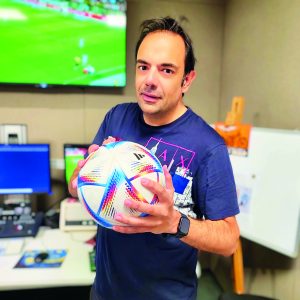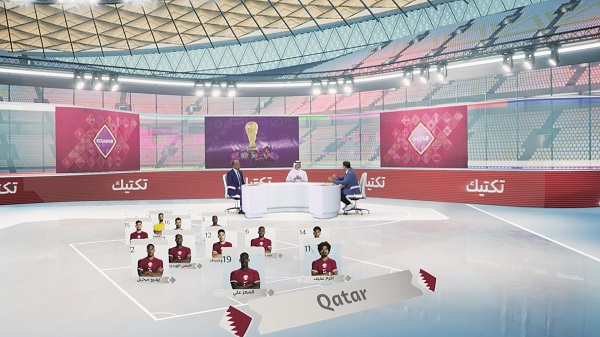The Qatari sports channel built a virtual studio in just three months, moving the goalposts for broadcasting in the region.
When it was confirmed that the 2022 World Cup would be held in Qatar, every regional sports broadcaster put its best foot forward to cover the tournament. With more than two decades in the sports broadcasting game, the team at Alkass Sports understood that a traditional approach wasn’t going to be enough to cover one of the biggest events on the sporting calendar.
“Local coverage of the World Cup was about far more than the event itself; it was an opportunity to represent Qatar on a massive scale and raise the bar for broadcasting in the country,” says Ali Majed, Director of the Creative Department at Alkass Sports. He explains that when that task first fell to the Alkass team, it began with a branding ad that reflected the cultural significance of the event and the history of its host country, highlighting the traditions and the iconic skyline of Qatar.

“After working with virtual studio graphics on that branding project, I knew it was time for us to rethink the future of our broadcasts,” Majed explains. “Initially we were going to build several physical studios for the World Cup, but I felt like we could do so much more. I’d been following Zero Density for the past five years, seeing what they offer the market. We decided to forgo our physical set plans and propose the idea of a Zero Density-powered virtual studio to our management.”
When the management was briefed on how a virtual studio would enable the Alkass team to create a realistic World Cup show and have multiple set designs in one green screen studio with endless innovative coverage options, they were all in. The only problem was they had just three months to do it all.

To help, the team contacted Zero Density, who were involved as technical advisers in the field with Alkass throughout the World Cup preparation and execution. “It was the first time we’d experienced a project of this scale in Qatar, and the pressure was on to ensure it could be completed to the high standards that audiences would expect within the limited time frame,” says Yavuz Bahadiroglu, Zero Density’s Global Partner Manager. “From the hardware to the lights and logistics, everything had to be built from the ground up. Zero Density’s expert team were on the ground from day one until the Cup was won.”
In order to create the virtual backdrops, first designs of Alkass Sports’s real-world studios were sent over to DreamWall, the company that would be creating the project’s virtual elements. DreamWall’s first challenge was to transform those plans into a virtual space that could be built and textured in Unreal Engine.
“We realised that the plans, intended for a real set, did not always match the 3D concept renderings,” explains Isabelle Denis, Sales Manager at DreamWall. “The concept renderings were flat in terms of textures, and we had to find solutions to improve everything and achieve a realistic final result. It was a challenge to stay close to the concept and still give the impression of depth.”

DreamWall needed to deliver the virtual space while keeping pace with Alkass, which was readying its biggest coverage of the year. Together both teams had numerous discussions about every detail of the virtual studio, from the tracking and camera setup to the number of anchors that would be on screen. “We even talked about the studio’s tables and whether they needed to be real or virtual, before the Alkass team settled on making them real,” recalls Denis.
Before unveiling the virtual studio to an audience of sports fans, the DreamWall and Alkass teams gathered copious references on each material with optimisation insights from Zero Density. They then used Unreal Engine’s texturing and shading capabilities to add subtle imperfections such as scratches and general wear and tear
“It may sound like a small touch, but it avoids flat colours without detail, a dead giveaway that what the audience is seeing isn’t real. Striving for absolute realism and perfection in virtual sets can be limiting and detract from the overall aesthetic and believability,” says Denis.

DreamWall’s team created everything in Zero Density’s Reality Editor, the fork version of Unreal Engine. When creating a realistic virtual environment for broadcast, however, there are some big things to consider, like finding the right workstations, cameras, lenses, lights and more. Zero Density provided consultancy on a wide range of topics, from the optimum size of the cyclorama to the ideal position of the lights and picking the right physical studio materials, in order to elevate the storytelling.
The final studio was built to include a 4.2m by 11.79m cyclorama painted with ChromaLight green basecoat and topcoat paints. The studio featured four Grass Valley LDX8000 cameras with Canon HDXS lenses, Stype technology for tracking and ARRI lights for cyclorama lighting. For the horsepower behind the production, Alkass opted for four Reality Engines running on RE AMPERE machines.
“We did everything in a short time, but we never settled for anything less than the best quality. We wanted top-notch results, or we would not do it, and it turned out the way we imagined it. As we warmed up to virtual studio production and with the trust that Zero Density’s support engineer would be present, our teams kept pushing the envelope and adding more and more virtual elements and features to each show.”

It was later decided that AR elements would help to further enhance Alkass’ coverage of the event. Green screen together with AR had been rarely used in the region. After the initial conceptualisation stage, AR elements were created. All green screen and AR elements were then controlled from the same interface on RealityHub. The Alkass team then used real-time data integration for team lineups and player names through Excel data that was fed into RealityHub.
Alkass was also keen to have its anchors teleport from one location to another. To do this, the remote location set up a small green background, adjusted the angle of the view so it was the same one used at the main studio, then sent the sound and picture to the studio. All input was placed in a plane object using Zero Density technology linking the render engine to the tracking system, allowing the Alkass team to have a photorealistic augmented guest on their set that could be transmitted from anywhere in the world.

Alkass believes that its coverage of the World Cup was a huge success, paving the way for even more virtual elements in regional sports broadcasting within Qatar. “By the time our work on the World Cup was complete, we had a fantastic football commentary show that cost us far less than a traditional broadcast, went above and beyond physical restraints with far more flexibility. And we did it all in just three months,” Majed adds.
Qatar is no stranger to huge sporting events and in the next 12 months alone there’s the Asian Cup, the World Championship, swimming and tennis, all of which will reach for the bar set by Alkass World Cup coverage. There’s even been a big investment in 4K to boost the quality of broadcast across the region. It’s safe to say that viewers can expect to see more and more virtual integration on their television sets.

“The technology has no limit in sports broadcasting,” says Majed. “It opens so many possibilities for instant replays, for a start. Then there are the various things you can do with AR, if you’re right there in the stadium you can open an app and instantly see information on all the players on the pitch, names, statistics through your phone. Thanks to the World Cup, regional sports broadcasting from now on is likely to be much more interesting than a conventional production.”







































































